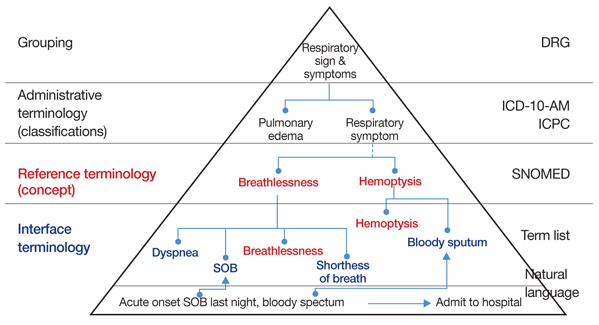J Korean Med Assoc.
2012 Aug;55(8):720-728. 10.5124/jkma.2012.55.8.720.
Use of clinical terminology for semantic interoperability of electronic health records
- Affiliations
-
- 1College of Nursing, Seoul National University, Seoul, Korea. hapark@snu.ac.kr
- 2College of Nursing, Eulji University, Daejeon, Korea.
- KMID: 1435178
- DOI: http://doi.org/10.5124/jkma.2012.55.8.720
Abstract
- Around the world electronic health records data are being shared and exchanged between two different systems for direct patient care, as well as for research, reimbursement, quality assurance, epidemiology, public health, and policy development. It is important to communicate the semantic meaning of the clinical data when exchanging electronic health records data. In order to achieve semantic interoperability of clinical data, it is important not only to specify clinical entries and documents and the structure of data in electronic health records, but also to use clinical terminology to describe clinical data. There are three types of clinical terminology: interface terminology to support a user-friendly structured data entry; reference terminology to store, retrieve, and analyze clinical data; and classification to aggregate clinical data for secondary use. In order to use electronic health records data in an efficient way, healthcare providers first need to record clinical content using a systematic and controlled interface terminology, then clinical content needs to be stored with reference terminology in a clinical data repository or data warehouse, and finally, the clinical content can be converted into a classification for reimbursement and statistical reporting. For electronic health records data collected at the point of care to be used for secondary purposes, it is necessary to map reference terminology with interface terminology and classification. It is necessary to adopt clinical terminology in electronic health records systems to ensure a high level of semantic interoperability.
MeSH Terms
Figure
Cited by 1 articles
-
Incorporation of Korean Electronic Data Interchange Vocabulary into Observational Medical Outcomes Partnership Vocabulary
Yeonchan Seong, Seng Chan You, Anna Ostropolets, Yeunsook Rho, Jimyung Park, Jaehyeong Cho, Dmitry Dymshyts, Christian G. Reich, Yunjung Heo, Rae Woong Park
Healthc Inform Res. 2021;27(1):29-38. doi: 10.4258/hir.2021.27.1.29.
Reference
-
1. Chaudhry B, Wang J, Wu S, Maglione M, Mojica W, Roth E, Morton SC, Shekelle PG. Systematic review: impact of health information technology on quality, efficiency, and costs of medical care. Ann Intern Med. 2006. 144:742–752.2. Institute of Electrical and Electronics Engineers Computer Society. Standards Coordinating Committee. IEEE standard computer dictionary: a compilation of IEEE standard computer glossaries. 1990. New York: Institute of Electrical and Electronics Engineers.
Article3. Veltman KH. Syntactic and semantic interoperability: new approaches to knowledge and the semantic web. New Rev Inf Netw. 2001. 7:159–183.
Article4. Garde S, Knaup P, Hovenga E, Heard S. Towards semantic interoperability for electronic health records. Methods Inf Med. 2007. 46:332–343.
Article5. Kalra D, Musen M, Smith B, Ceusters W, De Moor G. ARGOS policy brief on semantic interoperability. Stud Health Technol Inform. 2011. 170:1–15.
Article6. Kalra D. Electronic health record standards. Yearb Med Inform. 2006. 136–144.7. Dolin RH, Alschuler L, Boyer S, Beebe C, Behlen FM, Biron PV, Shabo Shvo A. HL7 Clinical Document Architecture, Release 2. J Am Med Inform Assoc. 2006. 13:30–39.8. Martinez-Costa C, Menarguez-Tortosa M, Fernandez-Breis JT. An approach for the semantic interoperability of ISO EN 13606 and OpenEHR archetypes. J Biomed Inform. 2010. 43:736–746.9. Dolin RH, Giannone G, Schadow G. Enabling joint commission medication reconciliation objectives with the HL7 / ASTM Continuity of Care Document standard. AMIA Annu Symp Proc. 2007. 186–190.10. Chute CG. Clinical classification and terminology: some history and current observations. J Am Med Inform Assoc. 2000. 7:298–303.11. Yun JH, Kim MJ, Ahn SJ, Kwak MS, Kim Y, Kim HK. The Development of clinical terminology dictionary for integration and management of clinical terminologies in EMR systems. J Korean Soc Med Inform. 2009. 15:411–421.12. Scott P, Macisaac P, Saad P. National Centre for Classification in Health. An introduction to health terminologies. 2002. Brisbane: National Centre for Classification in Health.13. Rosenbloom ST, Miller RA, Johnson KB, Elkin PL, Brown SH. Interface terminologies: facilitating direct entry of clinical data into electronic health record systems. J Am Med Inform Assoc. 2006. 13:277–288.14. Rector AL. Thesauri and formal classifications: terminologies for people and machines. Methods Inf Med. 1998. 37:501–509.
Article15. World Health Organization. International Classification of Diseases (ICD) [Internet]. cited 2012 Jun 20. Geneva: World Health Organization;Available from: http://www.who.int/classifications/icd/en.
Article16. International Health Terminology Standards Development Organisation. SNOEMD clinical terms [Internet]. cited 2012 Jun 20. Copenhagen: International Health Terminology Standards Development Organisation;Available from: http://www.ihtsdo.org/snomed-ct.17. Logical Observation Identifiers Names and Codes. Logical Observation Identifiers Names and Codes (LOINC) [Internet]. cited 2012 Jun 20. Indianapolis: Logical Observation Identifiers Names and Codes;Available from: http://loinc.org.18. American Medical Association. CPT-current procedural terminology [Internet]. cited 2012 Jun 20. Chicago: American Medical Association;Available from: http://www.ama-assn.org/ama/pub/physician-resources/solutions-managing-your-practice/coding-billing-insurance/cpt.page.19. Almqvist C, Wettermark B, Hedlin G, Ye W, Lundholm C. Antibiotics and asthma medication in a large register-based cohort study - confounding, cause and effect. Clin Exp Allergy. 2012. 42:104–111.20. Liu S, Ma W, Moore R, Ganesan V, Nelson S. RxNorm: prescription for electronic drug information exchange [Internet]. 2005. cited 2012 Jul 1. Washington, DC: IEEE Computer Society;Available from: http://165.112.140.110/research/umls/rxnorm/RxNorm.pdf.
Article21. Foley MM, Garrett GS. key issues shaping clinical terminology and classification. J AHIMA. 2006. 77:24–28. 30
Article22. Chiang MF, Casper DS, Cimino JJ, Starren J. Representation of ophthalmology concepts by electronic systems: adequacy of controlled medical terminologies. Ophthalmology. 2005. 112:175–183.
Article23. Qureshi AI, Harris-Lane P, Siddiqi F, Kirmani JF. International classification of diseases and current procedural terminology codes underestimated thrombolytic use for ischemic stroke. J Clin Epidemiol. 2006. 59:856–858.
Article
- Full Text Links
- Actions
-
Cited
- CITED
-
- Close
- Share
- Similar articles
-
- Clinical Terminologies: A Solution for Semantic Interoperability
- Establishing semantic interoperability in the course of clinical document exchange using international standard for metadata registry
- Contribution of Clinical Archetypes, and the Challenges, towards Achieving Semantic Interoperability for EHRs
- Implementation of a Next-Generation Electronic Nursing Records System Based on Detailed Clinical Models and Integration of Clinical Practice Guidelines
- The Development of Clinical Document Standards for Semantic Interoperability in China



